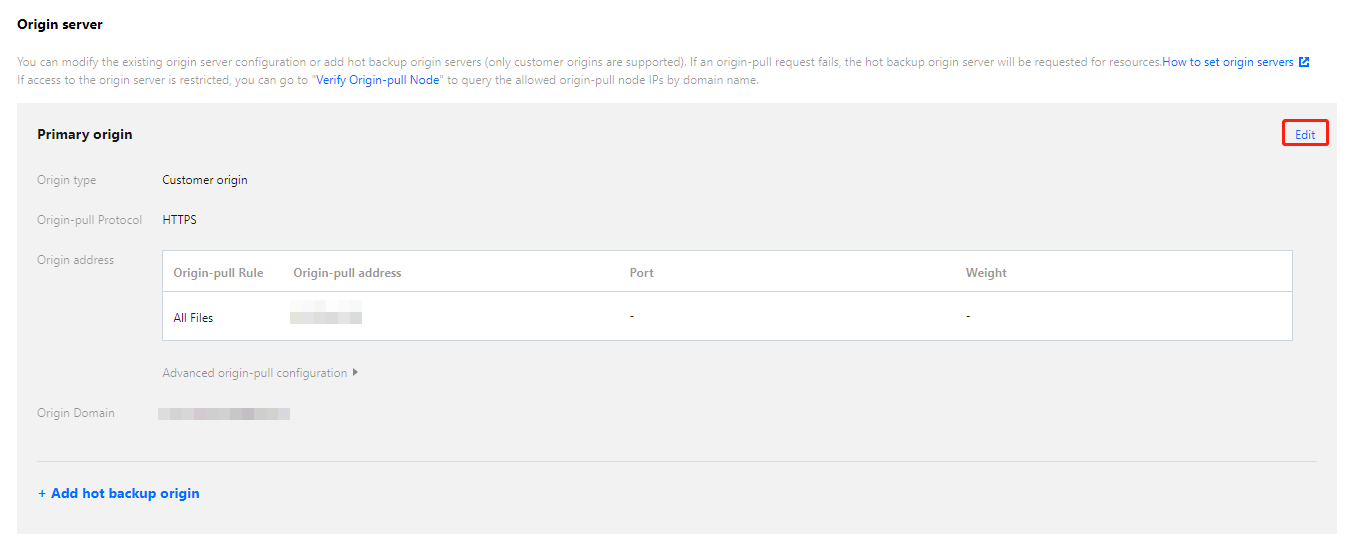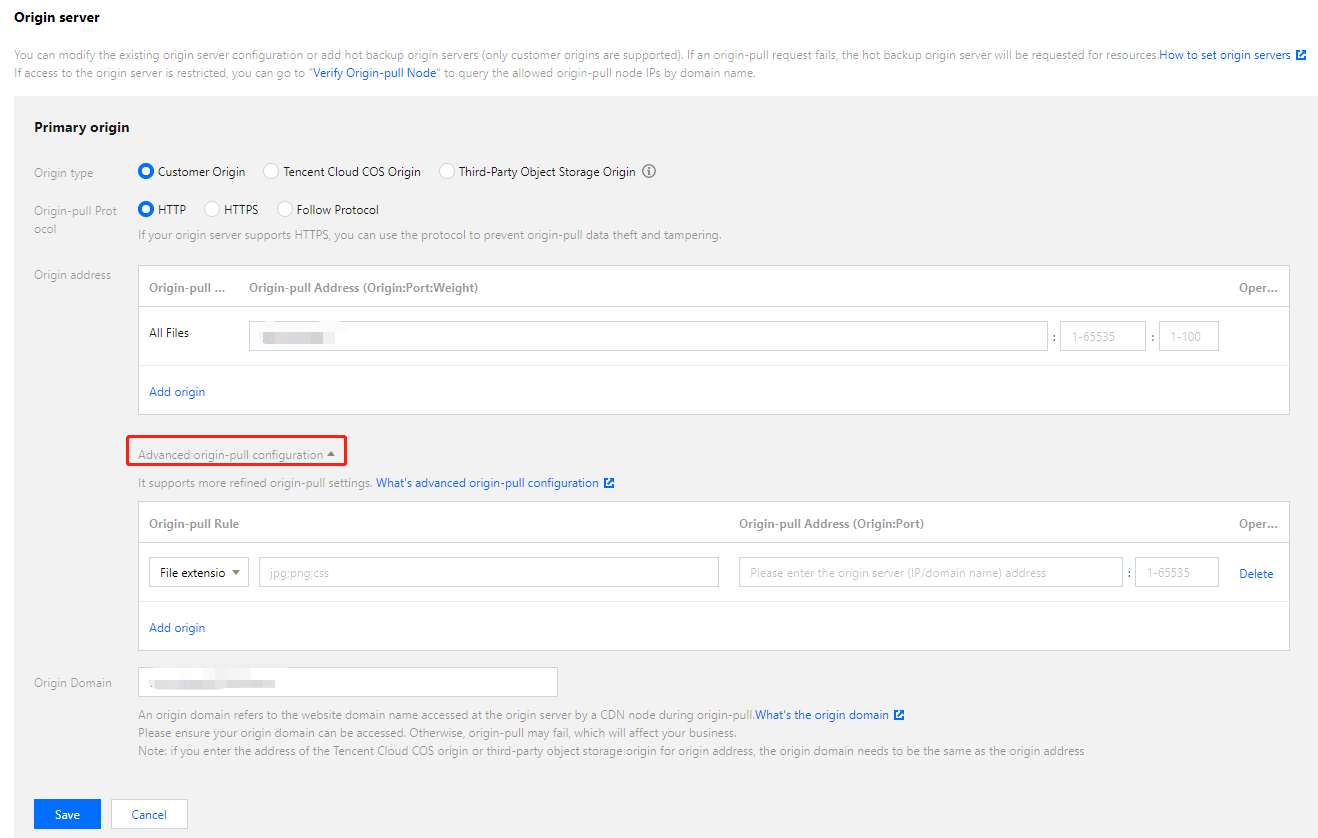- Updates and Announcements
- User Tutorial
- Product Introduction
- Purchase Guide
- Getting Started
- Configuration Guide
- Permission Management
- Use Cases
- Best Practice
- API Documentation
- FAQ
- Troubleshooting Methods
- CDN Service Level Agreement
- Glossary
- Updates and Announcements
- User Tutorial
- Product Introduction
- Purchase Guide
- Getting Started
- Configuration Guide
- Permission Management
- Use Cases
- Best Practice
- API Documentation
- FAQ
- Troubleshooting Methods
- CDN Service Level Agreement
- Glossary
Advanced origin-Pull configurations
Tencent Cloud CDN allows you to configure fine-grained origin-pull based on origin-pull rules, such as path-based rules (i.e., specifying a file type, folder, full file path, or homepage for origin-pull) and client IP region-based rules.
Restrictions
By default, the origin-pull protocol and origin domain of the primary origin server are adopted for the advanced origin-pull configuration and cannot be modified.
Configuration Guide
Configuration in domain management
- Log in to the CDN console.
- Click Domain Management on the left sidebar to enter the domain name management list.
- Select the target domain name and click Manage to enter the domain name configuration page.
- On the Baisc information tab, find the Origin server section and click Edit in the top-right corner of the Primary origin section.

- Click Advanced origin-pull configuration.

- Set the configuration items in the Advanced origin-pull configuration section as described in the following table.
| Item | Description |
|---|---|
| Origin-pull Rule | Client requests can be forwarded by the following rules: Client IP: This rule directs origin-pull requests of clients inside or outside the specified region to the specified origin address. File extension: This rule directs origin-pull requests for the specified file extensions to the specified origin address. If you specify multiple file extensions, separate them with semicolons (;). File directory: This rule directs origin-pull requests for files in the specified directory to the specified origin address. If you specify multiple directories, separate them with semicolons (;). Full path: This rule directs origin-pull requests for a specific file with its full path, such as /a/1.jpg, to the specified origin address. If you specify multiple files with their full paths, separate the files with semicolons (;).Homepage: This rule directs origin-pull requests for files on the homepage to the specified origin address. |
| Origin-pull Address | You can specify domain names or IP addresses. One origin-pull address is required for an origin-pull rule. In addition, the value of the origin domain specified for the primary domain name in the Origin server section is used. |
| Port | You can specify a custom origin-pull port number. If you do not specify custom port numbers, port 80 is used for origin-pull over HTTP and port 443 is used for origin-pull over HTTPS. The origin-pull protocol depends on settings of the origin server. If you select HTTPS for Origin-pull Protocol in the Origin server section, the requests hit by an advanced origin-pull rule are forwarded over HTTPS. |
Configuration limitations
- Each domain name can be configured with up to 50 rules.
- The origin-pull address of a single rule can be an IP, domain name, and port (range: 0 - 65535; port can be omitted). If "HTTPS" or "Follow Protocol" is selected as the origin-pull protocol, the port should be 443 or left empty.
- More actions: you can adjust rule priority and edit or delete multiple rules in batches.
Rule priorities
First, the priority of a client IP rule is lower than that of a path-based rule. Second, if multiple path-based rules are specified, rules at lower positions in the rule list have higher priorities.
For example, you have specified that origin-pull requests of clients from the Jiangsu region are forwarded to 1.1.1.1 and origin-pull requests for files whose path contains /test are forwarded to 2.2.2.2. When a client from the Jiangsu region accesses /test, the origin-pull request is forwarded to 2.2.2.2.
Sample configuration
Example:
This example describes three origin-pull scenarios, assuming that you have configured www.example.com as the CDN acceleration domain name, with the advanced origin-pull rules configured as shown in the following figure:
Scenario 1: A client from the Shanghai region accesses http://www.example.com/vod/. In this case, the origin-pull request hits the File directory rule and is forwarded to 1.1.1.3.
Scenario 2: A client from the Guangdong region accesses http://www.example.com/. In this case, the origin-pull request hits both the Homepage rule and the Client IP rule. As the Homepage rule has a higher priority, the origin-pull request is forwarded to 1.1.1.5.
Scenario 3: A client from the Guangdong region accesses http://www.example.com/image/1.jpg. In this case, the origin-pull request hits the File extension, Full path, and Client IP rules at the same time. As a path-based rule has a higher priority over an IP-based rule, and the Full path rule is listed lower than the File extension rule, the origin-pull request is forwarded to 1.1.1.4.

 Yes
Yes
 No
No
Was this page helpful?